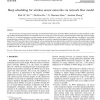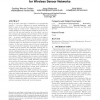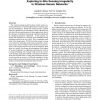138 search results - page 20 / 28 » Ensuring Area Coverage in Hybrid Wireless Sensor Networks |
COMCOM
2006
13 years 7 months ago
2006
The pervasiveness and operational autonomy of mesh-based wireless sensor networks (WSNs) make them an ideal candidate in offering sustained monitoring functions at reasonable cost...
INFOCOM
2009
IEEE
14 years 2 months ago
2009
IEEE
—We present the Flash flooding protocol for rapid network flooding in wireless sensor networks. Traditional flooding protocols can be very slow because of neighborhood content...
RTSS
2006
IEEE
14 years 1 months ago
2006
IEEE
Location services are essential to many applications running on a hybrid of wirelessly-networked mobile actors and static sensors, such as surveillance systems and the Pursuer and...
SENSYS
2009
ACM
14 years 2 months ago
2009
ACM
Energy in sensor networks is a distributed, non-transferable resource. Over time, differences in energy availability are likely to arise. Protocols like routing trees may concent...
TPDS
2010
13 years 6 months ago
2010
The circular sensing model has been widely used to estimate performance of sensing applications in existing analysis and simulations. While this model provides valuable high-level...



